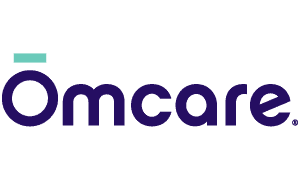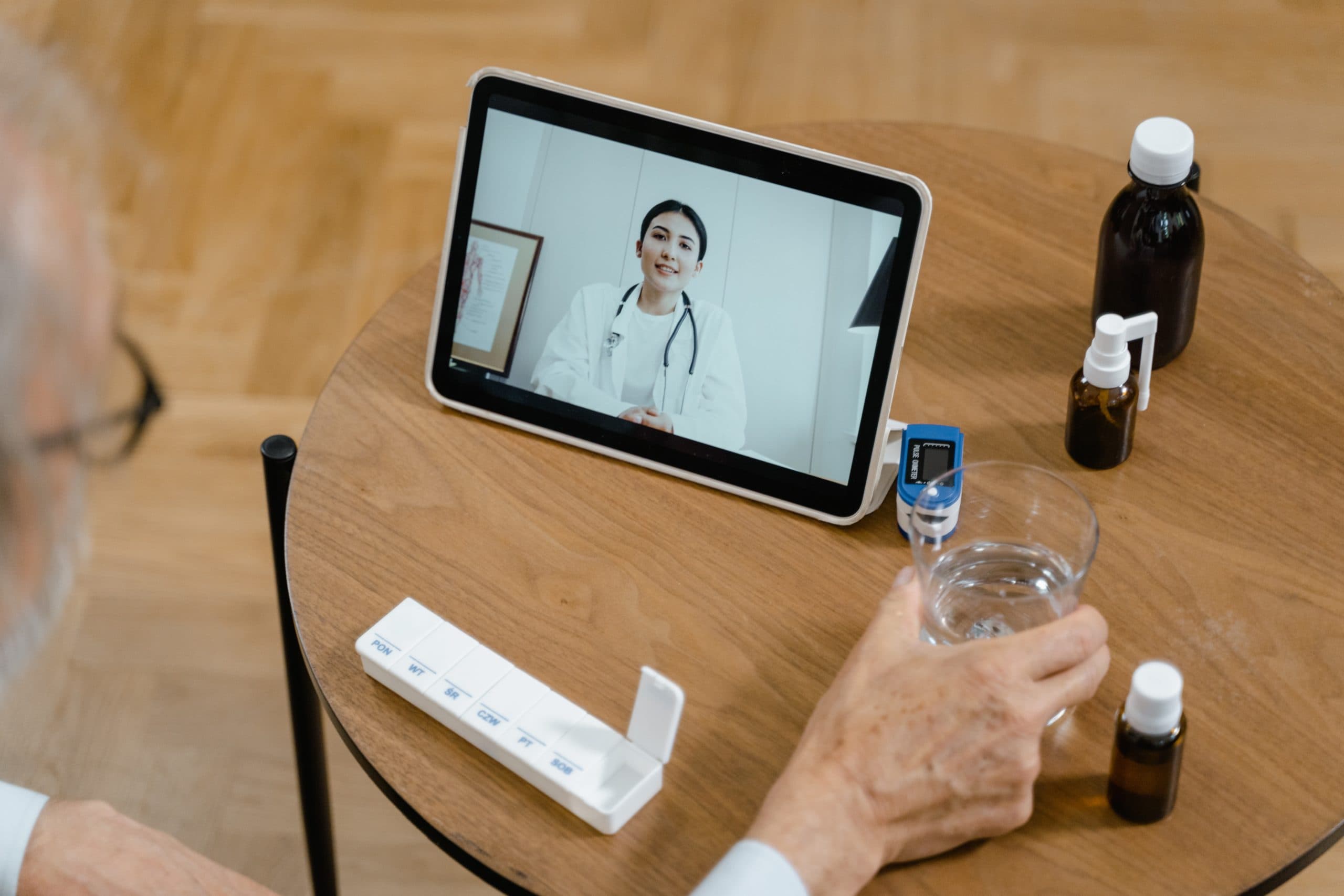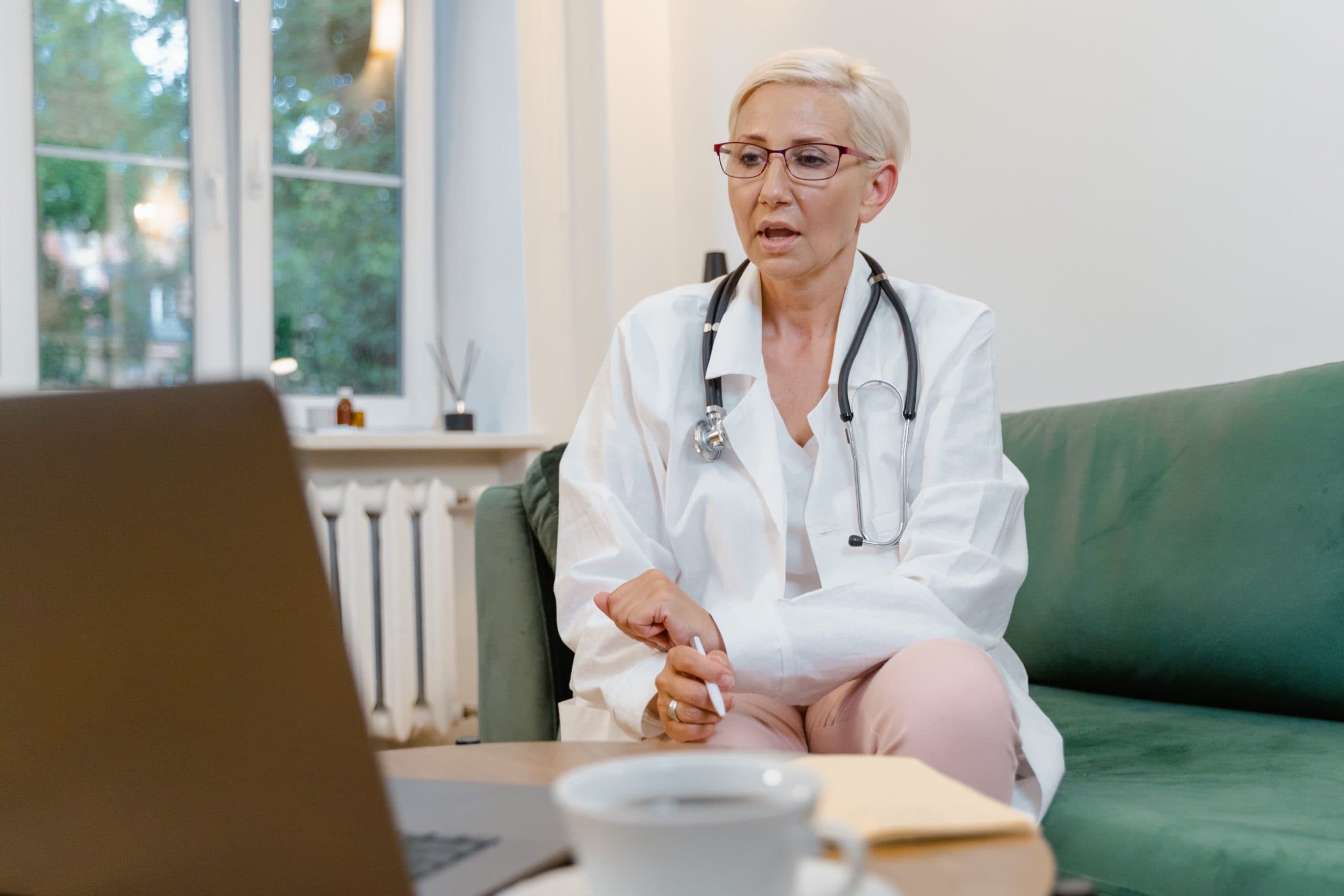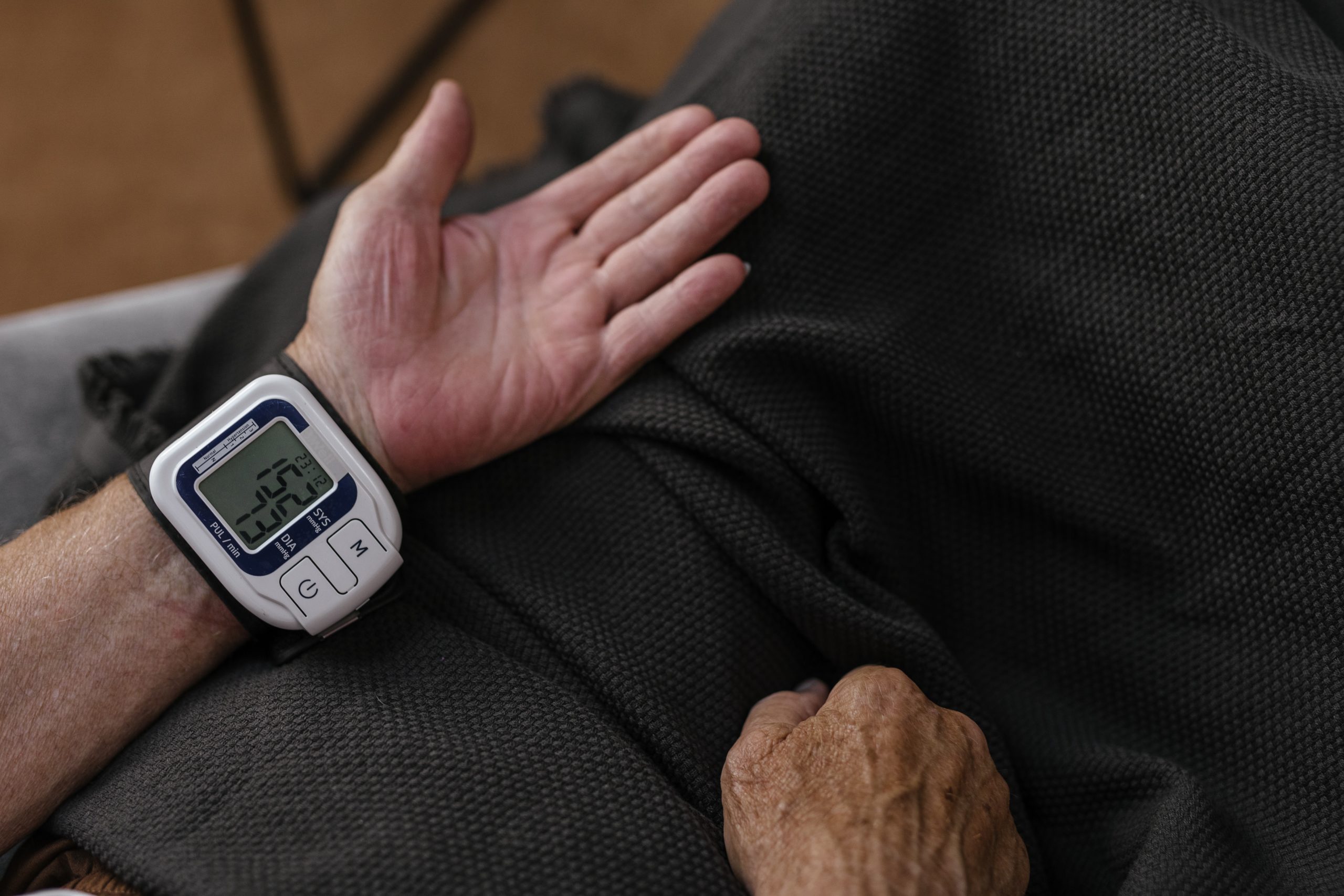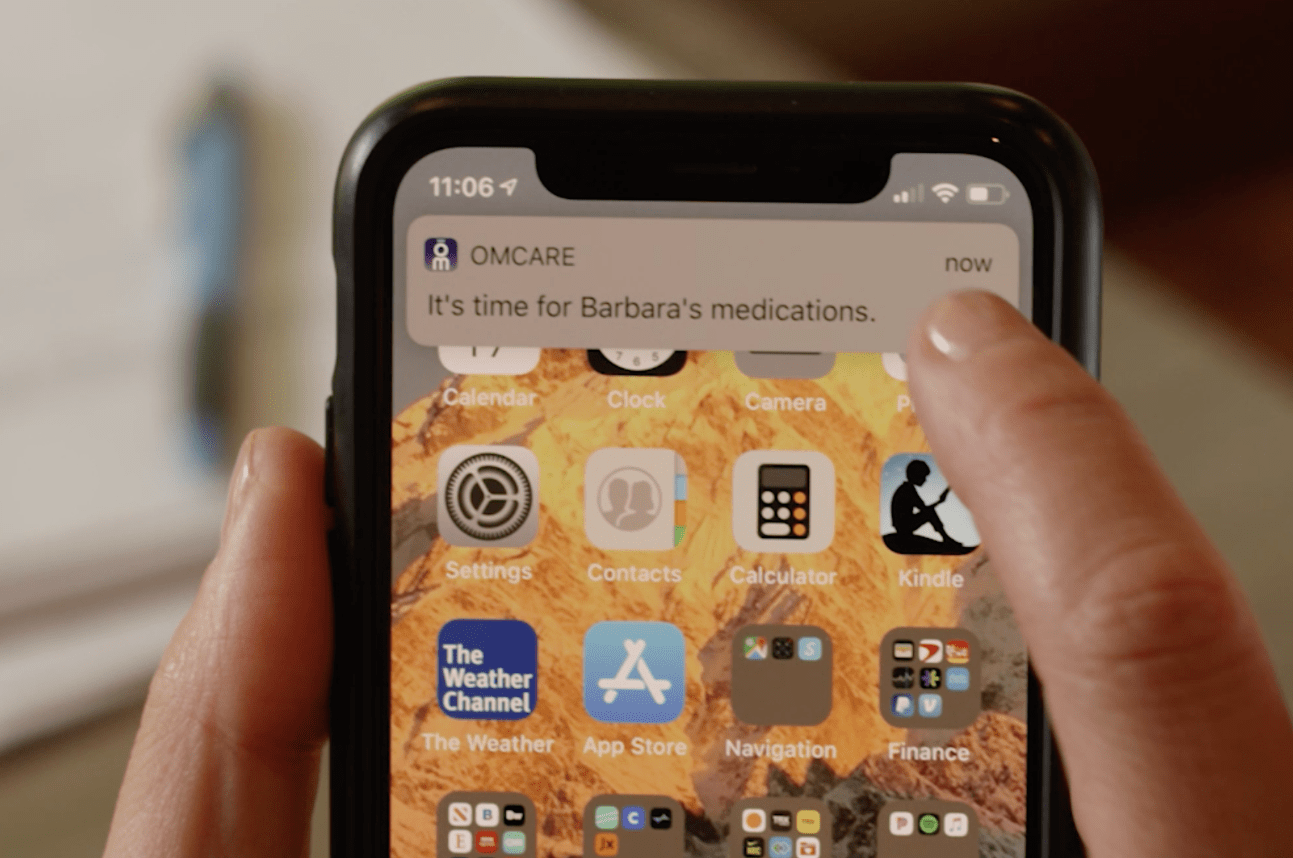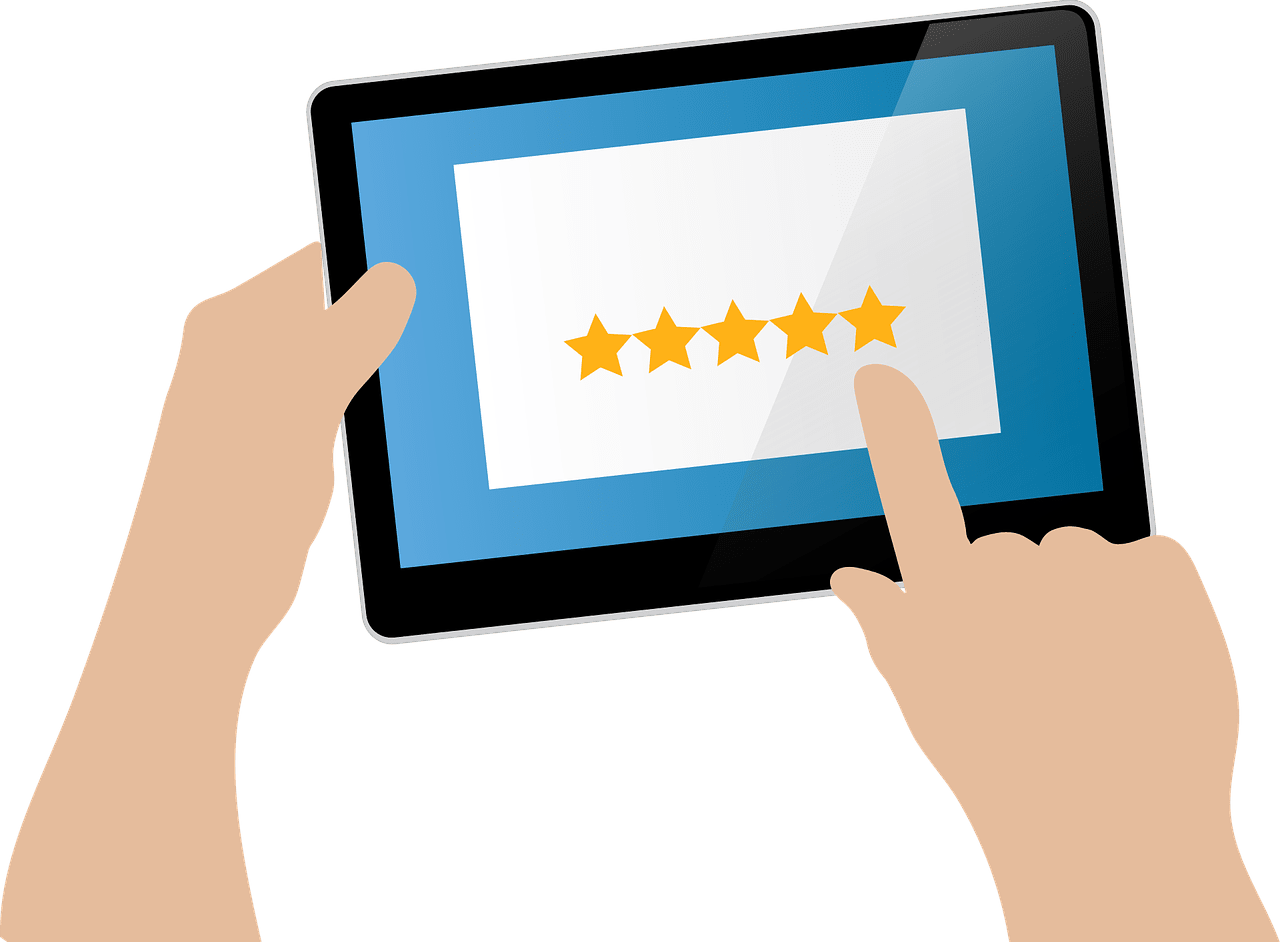Practicing good “webside” manner for senior care facilities: Our top tips
Telehealth can greatly improve the lives of elderly patients. It’s a cost-effective option that allows seniors to continue living in their own homes, which increases patient satisfaction. Plus, telehealth reduces the need for excessive traveling to appointments, and decreases the stress on caregivers.
As technology advances, providers are increasingly interacting with patients through phones and laptop screens. It can be challenging for providers to maintain their bedside manner. While virtual provider-patient interaction is different, many aspects do remain the same—providers still need to be friendly, compassionate, and trustworthy.
First, we’ll explore why bedside manner is important, and then we’ll explain how to apply bedside manner to virtual healthcare.
Why is bedside manner important?
Beside manner is the way providers interact with their patients. Good bedside manner is the art of treating patients like people, not just another number in your workday. eMDs writes, “Your ability to communicate with your patients with empathy, understanding, and in terms the patient understands creates a strong foundation for a lasting patient-provider relationship.”
Healthgrades found that 52% of patients say their doctor needs to have one of the following:
- Bedside manner
- Compassion
- Comfort
- Patience
- Personality
“Patients don’t just want to see a doctor, they want to be seen,” says Healthgrades chief medical officer, Dr. Bowman. And when patients do feel seen, they’re more likely to experience:
- Better provider-patient relationships
- Increased treatment and medication adherence
- Better healthcare outcomes
All of these benefits can be applied to virtual visits as well. Even when doctors aren’t bedside, they can still practice communicating with patients in a way that makes them feel seen. “Webside” manner is the bedside manner expressed via telehealth.
What is “webside” manner?
When delivering virtual healthcare, direct interaction and physical cues are limited. It makes it harder for providers to recognize nonverbal cues. Plus, telehealth can make it more challenging to connect with patients. Webside manner is seemingly harder, because it’s not quite the same as bedside manner. It’s like using a new muscle.
Dr. Brian Donley says compassion and bedside manner is like a muscle: “The more you exercise it, the stronger it gets.” And the same goes for webside manner.
So how can providers practice webside manner? Here’s how:
- Ask more detailed questions. Because you’re not able to get as many nonverbal cues, you’ll need the patient to give more detailed answers. And that starts with asking more detailed questions to encourage meaningful patient engagement.
- Use positive upper body language. Patients can only see your upper half. It’s important to use positive body language in your upper half. For example, nod your head in understanding, relax your shoulders, lean forward in interest, sit up instead of slouching, and look into the camera.
- Avoid fidgeting. Your equipment is most likely sensitive to small noises, even slight tapping or clicking of your pen. Avoid fidgeting, and be transparent with your patients if you’re typing or taking notes about them. They might think you’re multitasking, instead of listening to them. Also, wait to take a bite to eat until you hang up from the call.
- Listen intentionally. Being booked with patients can make it challenging to listen intently. Practice listening well and making your patients feel heard.
- Present yourself professionally. Even virtually, first impressions matter. Dress and present yourself professionally to show patients that you take your job seriously.
- Limit distractions in your background and choose great lighting. A blank wall behind you is best.
- Use a light and positive tone. Virtually, the best way to demonstrate empathy is by using a light and positive tone in your voice. The words you say are important too, but the tone you use is key.
- Close the appointment by reviewing the treatment plan. Make sure patients understand their plan, and leave extra time for questions to make sure that they have all the information they need.
Good webside manner starts with picking a great telehealth option.
One key component of webside manner is limiting technological distractions and hiccups. That means choosing a great telehealth option. Ōmcare’s Home Health Hub® a video-based healthcare solution to connect providers and patients. Reach out to Ōmcare today to learn more.
Employee Spotlight: Sajith Padmaja
June 21, 2022Employee SpotlightBlog
Name: Sajith Padmaja
Title: VP, Engineering
Education: Masters of Science, Software Systems
Time at Ōmcare: 11/01/2017 - present
One personal fact about you: I dream big. My idea of a pet while growing up in South India was an Elephant!
1. What led you to Ōmcare?
My quest for an opportunity to develop a ground-breaking product led me to Ōmcare. I started my career 22 years ago with a startup developing products for Bluetooth technology which was in its nascent stage then. Throughout my career I got opportunities to develop amazing products for organizations like Microsoft, DHL, and Medtronic. My experience at Medtronic—where I helped developed Bluetooth enabled Pacemakers—introduced me to medical device domain which I fell in love with. When the opportunity to lead Ōmcare’s product development came, I grabbed it with both hands.
2. What’s the most rewarding part of working at Ōmcare?
Creating a path-breaking product, the opportunities to learn new technologies, and getting to work with amazing people are equally rewarding.
3. What is your favorite current project you’re working on?
I enjoy every aspect of my work. My responsibilities include:
- Project management which means managing scope, schedule, cost, resources, risks, quality, and contracting
- Software development and testing which involves embedded systems and application development
- Site Reliability Engineering, which is a new area of focus for me and involves identifying and using software tools and architectures that enable our product to be more secure and reliable
4. Pick out a core value that means a lot to you. How have you seen this lived out in your time at Ōmcare?
All our core values mean a lot to me. But if I have to pick one, I’d choose “Acts with integrity and follows through.”
My day-to-day work involves resolving technological challenges—part of all product development—and the last thing I want to worry about is whether the other person in the room will do what is right. I see all our core values lived out at Ōmcare every single day. I see our team members proactively picking up difficult tasks, getting it done with good quality, and reporting back without any follow ups. We’re able to work like a well-oiled machine because all members of our team are professionals with high integrity.
5. What are you most proud of accomplishing throughout your time at Ōmcare?
I am grateful that working with a small but great team, I was able to make an amazing product that is currently helping people to take their medications on time and stay healthy. Starting with a list of product requirements, I led the effort of identifying the product architecture, choosing the hardware and software components, developing the strategy for quality and product security, and hiring engineers who are highly skilled. I am specifically proud of my contribution towards identifying components which are low priced but of high quality. This enables us to keep the cost of goods sold low, which in turn allows us to make the product more affordable.
3 Affordable alternatives to traditional home health care (2022 Update)
3 in 4 older Americans want to stay in their homes as they age. Yet, home healthcare has become increasingly expensive, and it’s no longer an affordable option for the average patient. In 2022, the median monthly cost for full-time home healthcare is $4,500.
That’s $54,000 a year.
Thankfully, there are a host of technological healthcare solutions available for patients who have conditions that need monitoring and treating. Before you decide to hire a nurse to come over daily, let’s explore other, more cost-effective healthcare options.
Technology’s role in home healthcare
Technology has opened up a world of possibilities for elderly people with disabilities and chronic diseases. Patients are no longer reliant on in-person healthcare to live independent lives.
“We’re already seeing some really interesting ways technology is being used to help people as they age,” says Ben Jonash, an author of The Future of Aging. Medical technology is allowing patients to age gracefully and in their own homes, even when they have health issues. These technologies represent alternatives for elderly patients to avoid expensive, in-person healthcare.
3 alternatives to home healthcare
1. Telemedicine
The first alternative to in-person healthcare is telemedicine. This is what it sounds like: a medical professional can provide their services through video chat, rather than in-person. Telemedicine, or telehealth, provides the following benefits:
- Promotes continuity of care
- Decreases the cost of care
- Improves patient self-management and clinical outcomes
- Reduces exposure to illness
With telemedicine, patients can still get the care they need, without stepping outside their homes. They’ll still receive access to the same healthcare that they would in-person. And at times, care is even more accessible, easier to get, and quicker.
2. Mobile Health
When a patient self monitors, then transfers the data to an online healthcare platform, it’s referred to as “mobile health.” Mobile health, similarly to telemedicine, represents another affordable alternative to at-home healthcare. Here are some examples of mobile health:
- Tracking dietary intake and glucose levels for diabetes management
- Remote patient monitoring (in these instances, devices do the monitoring for the patients)
- Point-of-care diagnostics
- Mobile health applications that connect patients with providers (for example, real-time messaging)
Another example of mobile health would be when a patient wears an emergency health tracking device. Medical alert systems can alarm doctors and emergency responders when patients can’t do so themselves.
Mobile health, in many cases, removed the need to have someone in the home, making it an incredible alternative to in-home healthcare.
3. Medication management
Technology greatly enhances the ability of providers to remotely manage medications, allowing easy access for patients.Online medication management is widely known as “telepharmacy.” These are applications that remind patients of refill schedules and allow them to easily message pharmacists to request refills.
Using online medication management, patients can have their medicine delivered. Some medication management tools even include automatic pill dispensers and medication reminders. By taking the entire process of managing medicine online, patients are more likely to adhere to their medication schedules, leading to more favorable health outcomes.
Technology drives better health outcomes
Nowadays, most patients can’t afford to drop thousands of dollars a month on full-time home healthcare. Thankfully, no one has to—with the help of technology. Now that you know the alternatives to home health care, all that’s left to do is find the right solution for you.
One option that offers telemedicine, mobile health, and medication management is Ōmcare’s Home Health Hub®. It’s a platform that offers patients and providers the ability to form a virtual relationship, checking in regularly, remotely. Patients can also request medication refills and have them mailed directly to their doors.
Reach out to Ōmcare to get started with telemedicine and online medication management.
Ōmcare appoints Matthew Grose as CTO
June 8, 2022PressPress Releases,News
Ōmcare appoints Matthew Grose as CTO
Grose will lead the development of the Ōmcare Home Health Hub® to bring remote care and medication adherence into the home.
[Minneapolis, June 8, 2022]. Ōmcare announced that Matthew Grose (MG) has been appointed Chief Technology Officer of the company.
An experienced engineering leader, MG spent the last seven years at Optum of UnitedHealth Group, most recently serving as Chief Engineer, VP Software Engineering. Before that, he honed his software skills at LifeTime — The Healthy Way of Life Company.
“Ōmcare has proven core functionality in pilot and is ready to accelerate development of its total solution”, said Lisa Lavin, Chief Executive Officer. “Bringing on a CTO with MG's experience and skills will enable Ōmcare to scale existing technologies while continuing to build innovative solutions for the future.”
While at UnitedHealth Group, MG’s contributions raised the bar of engineering excellence creating efficiency, scale and collaboration across business units. Notable highlights include serving as a Distinguished Engineer, leading the digital provider platform Link used by millions of providers a day, introducing sustainable and secure public cloud adoption and acting as Chief Engineer for the company’s technology platforms powering 40,000 engineers and technologists.
During the pandemic, MG stepped out of his normal duties and focused on increasing accessibility to COVID-19 vaccinations and the successful completion of CARES Act payments by leading rapid speed cloud projects spanning multiple companies, including fast-tracking a year-long cloud scaling plan in 5 weeks. Now, he brings both his software skills and leadership development to Ōmcare.
"I joined Ōmcare for the opportunity to create technology closer to the human experience while playing a pivotal role in the company's future. Ōmcare's purpose is a natural fit to my personal passion of improving quality of life through technology. It is exciting to imagine where home health care will be in 5, 10, 20 years and I'm honored to be playing a part here with Ōmcare. Let’s improve care in the home!” said MG.
Ōmcare is currently in final stages of pilot and expected to be commercial in late 2022.
About Ōmcare
Ōmcare is a digital health company pioneering a customizable home health technology platform that extends the reach of caregivers and enables one-touch access to telehealth services, aggregated remote patient monitoring and medication dispensing with visual confirmation of medication adherence.
Remote patient monitoring for chronic conditions
May 18, 2022Age Tech,Senior CareBlog
Gone are the days when patients needed to be monitored in-person. New technology gives patients the ability to live independently, while monitoring their chronic conditions from their own home. It also effectively lowers the cost of healthcare for patients and providers, since less in-person care is needed.
Although any patient can use remote monitoring tools, they are especially beneficial for patients with chronic conditions. The National Center for Biotechnology Information writes, “Chronic diseases are among the most important health problems to benefit from health remote monitoring systems (HRMS).”
What are chronic conditions?
Firstly, what are chronic conditions? These health conditions are defined as ongoing, incurable illnesses and diseases such as:
- Cancer
- Asthma
- Heart disease
- Diabetes
However, although these diseases are incurable, many are usually manageable. Yet, if they’re left untreated, they can be disabling and reduce a patient’s overall quality of life. For example, the American Diabetes Association writes that worldwide, a patient loses a limb every 30 seconds due to diabetes complications.
In order for these patients to avoid complications, their chronic conditions need to be monitored and effectively managed.
What is remote patient monitoring (RPM)?
Remote patient monitoring tracks health and vitals remotely with accuracy 24/7. These technologies gather health data from patients. Here are some examples of RPM tools for chronic conditions:
- Diabetes: Glucose monitor to measure blood sugar levels
- Heart conditions: Blood pressure monitor
- Respiratory conditions: Pulse oximeter to monitor blood oxygen saturation levels
- Obesity: Scale to manage weight loss
These RPM tools often give medical advice based on healthcare data. For example, the technology will provide relevant, helpful content about blood sugar management for patients with diabetes. This automated advice provides added emotional support and health guidance for patients and their families.
RPM can also alert providers if a patient’s data is uncontrolled. The care team can then make changes and updates to the patient’s health plan and medications as needed.
RPM (also known as remote vital monitoring) represents a solution that is effective, convenient, and cheaper for patients. With the help of RPM tools, patients with chronic conditions receive life-saving healthcare, without constant trips to the doctor’s office.
Remote patient monitoring benefits providers
RPM devices can decrease the strain on healthcare providers. Currently, in the United States, 7 in 10 patients die from chronic diseases. While dealing with the COVID-19 pandemic, providers were overwhelmed with an increase in patients with chronic diseases. That, combined with a healthcare labor shortage, makes RPM tools critical to relieving the burden on healthcare providers.
RPM gives providers the space to work on critical patients, until an emergency arises in the remote monitoring data. Until then, the technology can do the heavy-lifting of gathering the data and providing general advice.
Do patients prefer to be monitored remotely?
Many patients with chronic conditions prefer to use RPM to manage their chronic conditions. For example, a MSI International survey found that 43% of patients valued the convenience that RPM offers, while 39% of patients appreciated the efficiency of RPM. 37% of patients felt they had more control over their health due to RPM, and 36% felt more peace of mind thanks to RPM.
The American Heart Association advises that providers should rely less on frequent in-office monitoring, and more on at-home RPM. This gives patients independence, and reduces the disturbance in their daily lives, while making more data readily available.
Drive better outcomes with remote patient monitoring
RPM tools are preferred by both providers and patients. But what about healthcare outcomes? RPM can actually drive even better health outcomes for patients, because providers are more able to diagnose chronic conditions earlier. Patients and providers can then begin building a plan to avoid complications.
Diagnosing chronic conditions early is crucial for many diseases, including hypertension and diabetes. It’s even possible for patients to completely reverse prediabetes, or go into diabetes remission, if their blood sugar imbalance is found early.
Plus, RPM improves how patients manage their chronic diseases. RPM tools increase patient awareness of and engagement with chronic condition therapies and management strategies. For example, when patients are able to closely monitor their glucose levels, they can make more informed decisions moving forward.
Ōmcare contributes to chronic condition management
Ōmcare is a telehealth device that helps patients and providers manage long-term, chronic conditions. We’ve got your logistics covered; everything from medication delivery to regular, remote check-ins. Our Ōmcare Home Health Hub is easy to use and manage, for both patients and healthcare providers. Looking for a solution that is accessible anywhere you are? Don’t hesitate to reach out to Ōmcare today.
Technology's impact on cost utilization
In the United States, healthcare is one of the top expenses for American families. In 2020, Americans spent $4.1 trillion on healthcare (yes, trillion). That means on average, each person in the U.S. spent roughly $12,500. Many physicians are concerned that high healthcare costs are placing a burden on their patients.
However, to reduce the healthcare cost burden on patients, we need to first cut expenses for healthcare providers. Unfortunately, bad debt caused by uncompensated care continues to increase at health centers across the country. In 2020, 47% of hospitals experienced increased debt due to uncompensated care. 21% of hospitals owe at least $10 million in debt.
Technology improves efficiency, reducing costs
Although $1.7 trillion is invested annually in healthcare, the industry is inefficient and burdened with costs. However, technology can help both patients and providers in reducing costs. For example, the right technology allows doctors to detect, treat, and prevent diseases, which reduces the long-term cost of healthcare.
With rising labor costs, it’s the perfect time for the healthcare sector to embrace using technology to cut healthcare costs – while maintaining a high quality of care. If most providers adopted health technology, the efficiency savings could average over $77 billion per year.
Don’t be afraid of technology and automation
You might be skeptical of automating tasks, thinking it’ll reduce jobs and staffing. Your administrative staff will still have to manage these technical solutions and address other tasks, but they’ll be much more efficient and productive. Automation and technology are not replacements for staff, but rather, an empowerment tool.
New health technology helps reduce costs, offers a better patient experience, and encourages innovation.
How technology reduces the cost of healthcare
1. Lower staffing costs
Labor is one of the biggest operating expenses. Plus, overworking the same employees with tasks that could be automated can lead to medical staff burnout. This reduces the effectiveness of your employees.
By using technology, hospitals effectively manage their staffing schedules, while decreasing healthcare expenses. Data helps hospitals understand their staffing needs to avoid overworking and over scheduling employees. This can be done by looking at past shifts, plus examining the current patient needs. These apps can carry out real-time labor analysis to predict demands based on:
- The number of incoming patients
- The number of open beds
- Capacity
- Equipment status
This innovative labor technology can help hospitals avoid resorting to expensive alternatives, such as temporary hires or paying staff overtime.
2. Automate administrative tasks
Another key to lowering staffing costs is automating administrative tasks. The healthcare industry spends $2.1 billion on manual tasks for provider data management. These are poorly performed and error-prone. The entire industry could save 33%, or $13.3 billion a year if administrative tasks were automated.
Administrative tasks waste a lot of time. Doctors end up wasting their time on entering patient notes, rather than actually treating the patients. But why let doctors waste their time, when there is technology available that lets doctors automate these administrative tasks? For example, instead of manually entering test results, there are apps for you to scan the test results and import them automatically.
Mobile apps can help hospitals and practices save a lot of time. For example, apps can handle prescriptions, testing, appointment setting, answering patient questions, sending medication or appointment reminders, and insurance processes. Plus, technology can provide analytics that lead to better patient care.
3. Streamline marketing efforts
Another way to reduce staffing costs, while also increasing revenue, is to automate marketing efforts. Hospitals need to invest time and marketing into their business, and automation is the best solution. It helps you:
- Expand your reach and impressions
- Gain and nurture leads
- Acquire more patients
- Grow faster
Technology can give you data so you can take advantage of segmented marketing. For example, you can market your diabetes care specifically for diabetic or prediabetic patients. Segmented marketing helps you reach the patients who need your care.
Plus, technology allows you to automate email campaigns, social media posts, patient referrals, text messages, review generation, and more.
Marketing technology also provides analytics. These ensure your marketing team knows what’s effective, and what isn’t. When they know what types of content are resonating with your audience, they can keep driving engagement.
There’s always more to be done for marketing teams. Streamlining marketing efforts helps you generate more revenue while avoiding overworking employees.
4. Reduce the need for specialists
The overuse of specialists can make care very expensive. However, remote patient monitoring (RPM) tools can reduce costs by eliminating travel costs, hospital room expenses, and specialty fees. It also ensures that specialists are spending their time wisely.
Using RPM technology, providers can remotely monitor patients in real-time. The system can analyze their healthcare data, and alert doctors in real-time if a patient’s condition grows worrisome. Then, the provider can adjust the patient’s treatment plans.
When specialists are needed, technology makes it possible for them to utilize virtual appointments.
5. Offer telehealth
Remote care saves an average of $19-$121 per patient compared to traditional, in-person doctor visits. Plus, throughout the 2020 pandemic, telemedicine was the key advancement that helped doctors stay in touch with patients. Even after the pandemic, 43% of Americans want to continue opting for telehealth.
Remote care also helps providers save financially. They can offer primary care remotely, reducing unnecessary and expensive emergency room visits. It also saves time for providers. Physicians who use telemedicine reduce visit times by about 20%.
Telemedicine is proving to be one of the most important healthcare technologies moving forward. It improves healthcare, and lowers the cost for everyone. It’s affordable, and it saves everyone time.
Embrace technological advances
In healthcare, the trends are moving us to a place where artificial intelligence will be used more and more to speed up treatment and reduce costs. With an eye for innovation, new ways of delivering care are made possible, which improves the effectiveness of treatments. Durable, user friendly, and cost-effective systems give us another avenue to improve healthcare. The future of this industry is bright.
Looking for a technological solution to decrease costs? Ōmcare Home Health Hub® is a video-based, remote solution that allows patients to get their medicine and speak with their providers, pharmacist, or caregivers in real-time. Reach out to Ōmcare to learn more!
Assistance options for seniors living at home (that actually work)
As Americans age, health challenges make it harder and harder for them to live empowered and independent lives. A lot of older people want to stay at home, but they need specialized healthcare to do so. Staying at home with the help of workers isn’t always a viable option, especially considering the cost of those services.
But what if we turned to technology instead? 54% of doctors and patients said technology can reduce healthcare costs. Plus, digital health technologies are predicted to reduce the cost of healthcare in the U.S. by about $305 billion. A huge part in that reduction is among older people adopting age-tech to lower their expenses.
However, choosing the right technology options is challenging. Making poor healthcare decisions leads to wasted money and health risks. This blog post was created to help you sort through the best age-tech solutions in the market.
3 assistance options for seniors living at home
1. Medication alerts
Poor medication adherence can cause a host of problems such as complications and diseases. It also decreases function, ability to live independently, and quality of life. Plus, it causes increased treatment costs due to the increased use of expensive and specialized medical resources, and often increases the length of the patient’s hospital stay. Finally, it causes unnecessary medication changes.
Making medication adherence worse, many elderly patients are taking a long list of medications to manage long-term health conditions. 44% of men and 57% of women older than 65 years take 5 or more medications per week. 12% of patients in this age group take 10 or more prescriptions per week. This is an issue, because 50% of patients don’t adhere to chronic medications.
When it comes to situations where patients are struggling with Alzhiemer’s or Dementia, remembering to take medications is nearly impossible. To encourage positive healthcare outcomes, technology helps elderly patients adhere to their medication.
The first step to keeping a senior on track with their medication is to make sure they're organized. A daily pill dispenser is the most important tool for this job. These devices organize pills into individual containers that are marked by day and time. At the designated hour, a reminder goes off, prompting the senior to take the proper pills according to their prescribed dosage.
A good pill dispenser will have an alarm system that accounts for when a dose was or wasn't taken, but not all systems are created equal. Some are error-prone, while others aren't reliable enough to be trusted with someone's health. The best pill dispensers will also have automatic notifications sent out if there's no response after the alarm has gone off several times in a row.
Ideally, a pill dispenser can be combined with other in-home caregiving systems. Other apps can be used to send reminders to patients to help them adhere to long-term medication schedules.
2. Health monitoring
How do we create an environment where we drive positive healthcare outcomes? We need to make sure we're measuring things we want to measure, and taking care of them when issues arise. Great technological tools exist to track senior health accurately and handle problems effectively.
These tools monitor the patient’s metrics, such as blood pressure, 24/7 in real-time. Plus, these technologies can often give medical advice based on data from other devices. As of May 2020, 39% of family caregivers considered remote monitoring to track an elderly patient’s health.
When picking what tools to choose, focus on the ones that are specific to the patient's needs. For example, a patient with diabetes may not need any blood pressure monitoring. They need blood sugar monitoring. Also, doctors can recommend specific health monitoring tools for the patient.
3. Mobile medical alerts
Another option for older adults who wish to remain living at home is the mobile medical alert system. With the help of this technology, older adults can have access to emergency services 24/7.
Mobile alert systems may take the form of a wearable device or an app on a smartphone. They are designed to keep seniors safe no matter where they are. The devices often also include two-way communication, so that seniors can reach out if they need assistance.
If your loved one is prone to falling or has dementia, a mobile alert system may be the best choice for them, and it will allow them freedom from being constantly supervised by a caregiver. For example, Lifeline offers a medical alert service that allows users to press a button or two on a device that can be worn as a necklace or bracelet. Pressing the buttons sends an alert to either the user’s loved ones or emergency services and it comes with location tracking so that help can find them quickly if needed.
There are home care options that combine technology and real people.
The best options for home elderly care combine technology with an in-person caregiver. 53% of elderly patients said they prefer their healthcare to include a mix of medical staff and technology.
The advantages are numerous:
- Patients can live at home, rather than in a care facility, and still receive wide-ranging support.
- One caregiver can take care of multiple clients from different locations, saving time and money for everyone involved.
- If there's a medical issue, technology allows caregivers to respond quickly to the patient’s needs—without having to be present in person.
Need a healthcare solution that actually works? Our Ōmcare Home Health Hub® is your answer. It’s a video-based solution that allows elderly patients to manage their healthcare needs remotely. They can receive medications and speak with their providers, pharmacist, or caregivers in real-time. Reach out to Ōmcare to learn more!
How age tech is the next wave of healthcare
The world population is aging at an unprecedented rate. In 2019, one in 11 people were over the age of 65. By 2050, one in six people will be older than 65. By 2050, the population of people 80 years old and above is expected to triple. Never in human history have we had so many people reach old age.
As people grow older, their health issues increase. Healthcare systems need to be ready to handle this change. Age-tech is a huge opportunity to revolutionize the way older people experience care.
What is age-tech?
As the population ages, the demand for products that ensure older people can live comfortably, meaningfully, and independently will increase. Age-tech is technology designed to meet these needs.
Tech companies are tapping into the earning potential of age-tech products. For example, Lively a health technology provider, and Lyft, an app for rides, launched transportation services just for older adults.
The greatest market opportunity for age-tech providers is in healthcare. The Gerontechnologist features the 2021 Age Tech Market Map, and the top categories were:
- Health
- Wellness
- Senior Living
Although many people believe that the elderly don’t enjoy or use technology, 53% of older respondents said they would prefer a mix of medical staff and healthcare technology to manage their needs. Even if the elderly did prefer only medical staff, making that possible is becoming harder and harder.
The Care Gap and its effect on age-tech
One huge reason health care age-tech is increasingly popular is because of the Care Gap. Many countries are experiencing a shortage of caregivers, and the caregivers that are still working are getting burnt out. Caregiver burnout is a state of physical, emotional and mental exhaustion. Experts estimate 4 in 10 caregivers find their jobs highly stressful. This never-ending stress causes many caregivers to drop their exhausting jobs altogether.
The ongoing professional caregiver drought has shifted responsibility to personal caregivers, for example, family members, who spend an average of 24 hours a week providing care, all unpaid. But these personal caregivers have their own career, lives, and even their own children to care for as well.
Healthcare age-tech can provide technological solutions to bridge the Care Gap. This can ease the burden on all caregivers, personal and professional. But even with all the benefits of age-tech, will the older population be able to and want to use healthcare technology?
Do older people want to use health care age-tech?
There are sure to be people with doubts about the effectiveness of age-tech. There are stereotypes that the older generation can’t use or don’t want new technology. However, the American Association of Retired Persons (AARP) reports:
- People 50 years and older use technology at the same pace as younger adults.
- 3 in 4 older Americans want to stay in their homes, and technology helps them achieve that goal.
- 40% of older respondents indicate they are interested in using technology for medication reminders.
- 21% of older Americans are open to videoconferencing with their doctors.
Not only can older people use healthcare technology, but they want to as well. But what kind of medicine counts as health care age-tech?
What is health care age-tech?
While age-tech is a broad term, here are some examples of age-tech specific to healthcare:
- Health monitoring
- Personal emergency response system (PERS)
- Medication management
- Telehealth for healthcare communication
- Hearing aids
These examples of healthcare age-tech not only help the elderly, but they also help everyone around them.
Age-tech benefits everyone
There’s no reason not to embrace age-tech; It eases the process of providing healthcare, and it also helps those receiving it. For the older generation receiving care, age-tech helps them maintain a sense of freedom. For caregivers, it alleviates stress..
If you’re looking for a healthcare solution for seniors, our Ōmcare Home Health Hub® is your answer. It’s a video-based, complete care-in-the-home solution that ensures users can get their medicine and speak with their providers, pharmacist, or caregivers in real-time. Reach out to Ōmcare to learn more!
Creating empathy through technology for the aging population
March 22, 2022Age Tech,Senior CareBlog
Empathy is not just a “nice to have” in healthcare—it has been shown to have strong positive effects on health outcomes. Additional research shows that empathy and compassion are associated with:
- Better adherence to medications
- Decreased malpractice cases
- Fewer healthcare mistakes
- Increased patient satisfaction
Empathy is especially important when caring for the aging population. As people grow older, their needs increase. They become increasingly vulnerable, and it can be difficult or uncomfortable to explain their needs. They may even hesitate to explain symptoms to avoid being a burden on caregivers.
As technology continues to grow as an option to provide care to the elderly, it’s important to foster empathy through the screen. Creating empathy through technology is certainly challenging, but for age-tech to succeed, it’s essential.
How to create empathy through technology for the aging population
1. Provide telehealth options connecting older patients to their healthcare providers.
Although it is harder to give patients the sense of personal care through technology, there’s also a unique opportunity for them to be more connected to their healthcare providers than ever before. Technology can maintain and improve the relationship between clinicians and patients.
Where patients did not have easy access to their healthcare providers in the past, now, they have healthcare technology to foster connectedness. Real-time chats allow patients to ask their doctor a question, ask for a refill, or so many more, all from the comfort of their own home.
Virtual appointments and consultations, portals giving access to health data, and group chats for sharing information all create connections.
2. Think about empathy beyond the typical doctor-patient relationship.
Although empathy through technology takes extra effort and thought, if done correctly, it may actually allow providers to be more empathetic. Technology transforms the typical doctor-patient relationship.
“We need to make ourselves available to them in ways that are perhaps sometimes not always possible when we're in the hospital setting,” says Kathy Sienko, OBE, the chief nurse at King Faisal Specialist Hospital and Research Center. “Giving them access to information, incorporating online information and other sources of data into the way that we deliver care, in ways that we have not been able to do before, or haven't been motivated to do before.”
Technology allows providers to go beyond the typical patient-doctor relationship. Sharing increased information during times of illness, uncertainty, and aging is a powerful way for doctors to demonstrate empathy for patients and their families.
3. Expand your perception of empathy.
Empathy is usually thought of as an understanding between two people, but empathy can go far beyond doctor and patient. An organization can embody empathy and be embedded within the patient experience.
Empathy can be as simple as designing apps that ease the stress of booking appointments. The “intersection between empathy and innovation and how they should be deeply intertwined to be maximally effective,” says Adrienne Boissy, MD, MA, chief experience officer at the Cleveland Clinic. “The experience of care, what does that need to feel like and how can we redesign things to make people feel cared about, and valued, and known, by an organization?”
Especially when it comes to senior populations, who might have more trouble accessing technology, the user experience is a priority. Technology can drastically improve their healthcare. However, if it’s too challenging to use, then that care experience is not empathetic and ineffective.
4. Empathy for clinicians helps patients.
The same healthcare tools that can be used for elderly patients can also be used to benefit clinicians. This is especially important, because clinician burnout is on the rise. Caregiver burnout leads to mental and physical health problems.
“In the face of the unprecedented challenges created by the COVID-19 pandemic, the nation must acknowledge the toll that the crisis is taking on the well-being of clinicians,” writes the National Academy of Medicine. “Health care workers need support as they navigate the difficult challenges of the current moment and throughout the long-term effects of COVID-19 on clinicians.”
Technology can provide empathetic support for clinicians. For example, virtual communication allows clinicians to connect with others in their field experiencing the same struggles. Wellness tools, such as Headspace, benefit the mental health of clinicians.
Also, allowing clinicians to provide telehealth helps them avoid burnout by saving them time. On average, physicians who use telemedicine reduce visit times by about 20 percent. This gives them more time throughout their day and alleviates stress.
When clinicians are less burned out, they are better able to offer empathetic care and drive positive health outcomes for the elderly population.
Technology improves older patient and clinician health
Rather than thinking of how challenging it is to be empathetic via technology, think of virtual healthcare as the ultimate tool. Our Ōmcare Home Health Hub® can help you provide an empathetic healthcare experience for the older generation. It allows an easy way to ensure patients are adherent with their medications and speak with providers in real-time. Reach out to Ōmcare to learn more today!
2022 changes for Star Ratings & how this affects your telehealth strategy
March 16, 2022Senior Care,Medicare AdvantageBlog
Every year, the Centers of Medicare & Medicaid Services (CMS) releases Star Ratings to determine how well Medicare plans perform. These ratings have big implications for plans including how members enroll. The system supports CMS’s efforts to empower people to make healthcare decisions that are best for them.
As for providers and plans, the factors that influence Star Ratings, and how heavily they influence them, change annually. Just when you have it figured out, they change again. This blog post explains the 2022 changes for Star Ratings, how these changes affect your telehealth strategy, and how to move forward into 2023 and 2024.
What are Star Ratings?
Plans are rated on a 1-to-5 scale, with one star representing poor performance and five stars representing excellent performance. When a plan is rated higher, more people enroll in it for a variety of reasons.
Star Ratings are based on:
- Staying healthy: How well does the plan keep members healthy through checkup reminders and communication?
- Managing chronic conditions: How well does the plan help members get recommended tests and treatments for their condition?
- Member experience: How do members rate their experience with the plan? This includes the care they receive from doctors and getting prescription medications.
- Member complaints and performance: How often do members find problems with the plan? How has the plan’s performance improved each year?
- Customer service: Does the plan have foreign language interpreters and teletypewriter (TTY) services available? Does the plan process appeals and new enrollments in a timely manner?
These categories are the main factors determining Star Ratings. However, there are other factors determining Star Ratings that change.
Keep reading to learn how 2022 Star Ratings differed from the past, and what factors influenced these changes.
2022: A record-breaking year for Star Ratings
2022 was a record-breaking year with the highest number of 4- and 5-Star Ratings. In 2022, there were more 5-Star plans than 3-Star plans.
The first reason for the increase in Star Ratings is the “better of” methodology. This change allowed plans to report data from either the 2021 or 2022. Plans had the benefit of choosing whichever year had the better data. The “better of” methodology will no longer be allowed, which means we can expect a drop in Star Ratings in the coming years.
Plans need to prepare for the future, because the CMS Star system will correct from COVID, leading to a significant loss in 4- and 5-Star Plans. Aside from the “better of” methodology, there were several other changes to 2022 Star Ratings.
Most influential change to Star Ratings in 2022: CAPHS Weighting
In 2022, Star Ratings continue to place an emphasis on member experience by having an increased importance and weighting. Consumer Assessment of Healthcare Providers and Systems (CAHPS) scores are shifting from two times to four times weighting.
CAPHS scores are often the lower performing category for health plans. Yet, in 2022, it becomes the highest weighted in the Star Ratings. Here is a breakdown of the CAPHS measures affecting Star Ratings:
- Getting needed care
- Getting appointments quickly
- Customer service
- Rating of healthcare quality
- Rating of health plan
- Care coordination
- Rating of drug plan
- Getting needed prescription drugs
Member experience was by far the most important change in 2022 Star Ratings, and this trend will continue in the future.
More changes to 2022 Star Ratings
In 2022, the plans that scored the highest were those that showed improvement in these measures:
- Transition of Care (TRC): This measure assesses post-discharge transition from inpatient facilities.
- Medication adherence for chronic conditions: How well did the plan help patients get medications? Did the plan include refill reminders?
- Preventive services: Did the plan have the ability to reach members digitally and in a timely manner?
- Chronic conditions: Members with chronic conditions often have compromised immune systems, making them more fearful of contracting COVID-19. Did the Plan increase the use of test kits, in-home services, and mobile unites to accommodate those with chronic conditions?
- Blood pressure: Did plans engage members with uncontrolled blood pressure?
In 2022, the Star Ratings removed the Health Outcome Survey (HOS) measures. Before, they had a 3x weighting.
The removal of the HOS measures boosted most plans’ ratings, and this change will last for at least the next 3 years.
Moving forward: Stars Ratings in 2023 and 2024
2022 Star Ratings were already solidified, meaning from now on, plans need to focus on Star Ratings for 2023 and 2024.
Here are the changes we’ll see for 2023 Star Ratings:
- CAPHS: Member experience weights increase to 4x for 2023.
- Health outcomes survey (HOS): 3x-weighted HOS measures won’t be counted for the next 3 years.
- Controlling blood pressure (CBP): CBP continues to be included in 2023 Star Ratings after methodology updates with a 1x weight.
In 2024, here are the Star Ratings changes to be aware of:
- Plan all-cause readmissions (PCR): This measure will return to the Star Ratings program with changes in 2024. PCR assesses the rate of adult acute inpatient observation stays that followed an unplanned acute readmission for any diagnosis within 30 days after discharge.
- Transitions of care (TRC): This measure assesses post-discharge transition from inpatient facilities with 3 new indicators.
- Follow-up after emergency department visit for people with multiple high-risk chronic conditions (FMC): This new measure tracks the percentage of adults with multiple high-risk conditions who had a follow-up service within 7 days of their visit.
The 2023 and 2024 changes to Star Ratings reveal trends to keep an eye on for the upcoming years. Now that you understand 2022, 2023, and 2024 changes to Star Ratings, we’re going to unpack how these changes impact your telehealth strategy.
How these changes impact your telehealth strategy?
By far the most important factor are CAPHS member experience measurements. How does telehealth impact member experience? Virtual visits have a higher patient satisfaction rate of 97%. In contrast, in-person visits have a 84% satisfaction rate. Just by offering telehealth services, a plan may be able to improve its Star Ratings.
When offering virtual visits, here’s how to improve patient satisfaction rates:
- Move as many experiences to virtual as possible, including prescription refills, ordering future screenings, assessments, medical recommendations, pain screenings, and depression screenings.
- Offer a Digital Mock-CAPHS Survey to better understand and improve member experience.
- Focus on how to use telehealth to improve other Stars measurements. For example, offer telehealth monitoring of blood pressure to monitor patients.
One key to improving member experience and providing higher touch care to more patients is to digitize medical services, when appropriate.
Need help providing telehealth?
With Star Rating improvements relying so heavily on telehealth, plans need to make sure their digital strategy is in great shape. Just like any other tool, there are great telehealth tools, and there are some that will just further frustrate members.
To help improve your telehealth services, rely on our Ōmcare Home Health Hub®. It ensures patients can get their medicine and speak with their providers, pharmacist, or caregivers in real-time. Reach out to Ōmcare to learn more!
